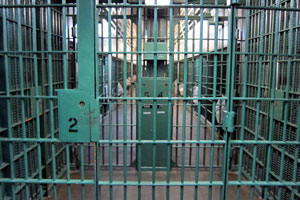Realignment is one of those terms that seems to connote nothing about its true meaning. (It has nothing to do with brakes, for instance.)
That's unfortunate, because what we talk about when we talk about realignment is nothing less than the unprecedented overhaul of California's criminal justice system, spurred by a U.S. Supreme Court decision affirming that California's prisons were so overcrowded that they violated the Eighth Amendment's ban on cruel and unusual punishment.
(One of our most trafficked posts of all time, by the way, is this one showing photos of packed-in inmates that the Supreme Court took the highly unusual step of including with its decision.)
KQED's Matthew Green explains what's happened since:
Last October California began a dramatic overhaul of its severely overcrowded prison system. Assembly Bill 109 — known as realignment — had the objective of shedding more than 30,000 inmates from in-state prisons and significantly cutting the prison budget. At the time the law took effect, there were more than 143,000 inmates behind bars in California's 33 prisons - about 190 percent of the system's design capacity.
Meanwhile, California's Department of Corrections and Rehabilitation (CDCR) received about $10 billion a year from the state's thinning general fund – over 11 percent of last year's entire spending plan. That's more than was spent on the University of California and California State University systems combined...
Since October, when realignment began, most "non-serious, non-violent, non-sex offenders" (as defined by the California's Penal Code) have been sentenced to county jails or put in locally-run probation programs. The program shifts a huge amount of criminal justice responsibility and power from the state to the local level. Prior to last October, every county came up with it's own individualized plan for how it would handle a potential increase in inmates and parolees. Each county then received an allotment of state funding based on its specific plan and the projected number of new inmates.
But as state prisons have come into compliance with the court order to reduce the number of inmates, you may wonder how the counties, newly conscripted to house offenders who would have formerly been the responsibility of the state, are holding up.
